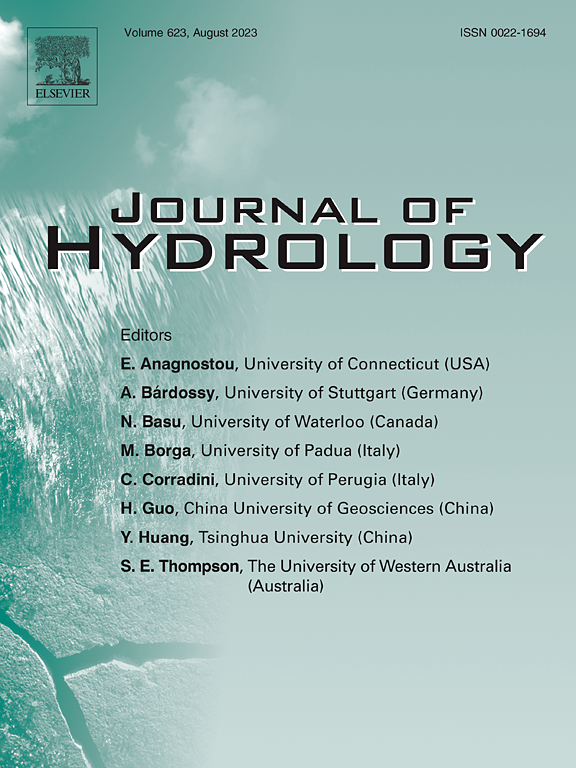研究了在整个区域范围内Φ值在α频率计算中的P-Ⅲ分布的方法
IF 5.9
1区 地球科学
Q1 ENGINEERING, CIVIL
引用次数: 0
摘要
P-Ⅲ分布的频率计算在降雨估算、洪水预报和各国生态流量分析等应用中起着关键作用。Φ值的确定是计算的关键。传统上,Φ值是通过插值从表中导出的,由于涉及的复杂性,这引入了计算不准确性。为了解决这一问题,开发了一种改进的高精度数值积分算法。这种增强的方法将集成间隔划分为三个不同的部分。它采用级数展开、替换和连分式技术来跨这些段执行数值积分,从而获得0到100范围内α值的Φ值。它解决了在临界点x = α + 1处收敛缓慢的问题。对于α值在100 ~ 1600之间,精心构造分布函数,并使用改进的高精度数值积分算法和构造的分布函数计算Φ值。它解决了当α大于100时的数据溢出问题。当α超过1600时,采用近似函数法确定Φ值。利用这种综合方法,建立了P-Ⅲ分布Φ值的全量程计算方法。通过将其结果与已建立的真值进行比较,验证了该方法的准确性,表明该方法的计算与真值匹配到小数点后三位。该方法不仅精度高,而且计算速度快,可以替代传统的Φ值表,提高水文领域P-III分布频率曲线的计算精度。本文章由计算机程序翻译,如有差异,请以英文原文为准。
The study of the method for the Φ values across the entire regional range of α in the frequency calculation of the P-Ⅲ distribution
The frequency computation of the P-Ⅲ distribution plays a pivotal role in various applications such as rainfall estimation, flood forecasting, and ecological flow analysis across various countries. The determination of Φ values stands as the crux of this computation. Traditionally, Φ values are derived through interpolation from a table, which introduces computational inaccuracies due to the complexity involved. To address this, an improved high-precision numerical integration algorithm has been developed. This enhanced method segments the integration interval into three distinct parts. It employs a series expansion, substitution, and continued fraction techniques to perform numerical integration across these segments, thereby obtaining Φ values for α values in the range just above zero to 100. It resolves the issue of slow convergence at the critical point x = α + 1. For α values between 100 and 1600, the distribution function is meticulously constructed, and Φ values are calculated using both the improved high-precision numerical integration algorithm and the constructed distribution function. It tackles the data overflow issue when α is greater than 100.When α exceeds 1600, an approximate function method is utilized to determine Φ values. By employing this comprehensive approach, a full-range calculation method for Φ values of the P-Ⅲ distribution is established. The accuracy of this method is validated by comparing its results with established truth values, revealing that the method’s calculations match the truth values to three decimal places. The method not only boasts high accuracy but also exhibits swift computational speed, making it a viable alternative to traditional Φ value tables and improving the accuracy of the calculation of the P-III distribution frequency curve in the field of hydrology.
求助全文
通过发布文献求助,成功后即可免费获取论文全文。
去求助
来源期刊

Journal of Hydrology
地学-地球科学综合
CiteScore
11.00
自引率
12.50%
发文量
1309
审稿时长
7.5 months
期刊介绍:
The Journal of Hydrology publishes original research papers and comprehensive reviews in all the subfields of the hydrological sciences including water based management and policy issues that impact on economics and society. These comprise, but are not limited to the physical, chemical, biogeochemical, stochastic and systems aspects of surface and groundwater hydrology, hydrometeorology and hydrogeology. Relevant topics incorporating the insights and methodologies of disciplines such as climatology, water resource systems, hydraulics, agrohydrology, geomorphology, soil science, instrumentation and remote sensing, civil and environmental engineering are included. Social science perspectives on hydrological problems such as resource and ecological economics, environmental sociology, psychology and behavioural science, management and policy analysis are also invited. Multi-and interdisciplinary analyses of hydrological problems are within scope. The science published in the Journal of Hydrology is relevant to catchment scales rather than exclusively to a local scale or site.
 求助内容:
求助内容: 应助结果提醒方式:
应助结果提醒方式:


